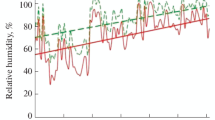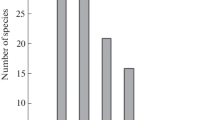Abstract
The allelochemic activity of the polyphenolics isolated from the leaves of four west African rain-forest plants,Acacia pennata, Cynometra leonensis, Diospyros thomasii, andTrema guineensis, was examined by means of protein precipitation experiments to estimate their specific activity as precipitants. Results indicated that light-induced phenol synthesis in the more heavily insolated foliage of a species led to greater protein-precipitating capacity in these leaves. It is considered doubtful that this produced a quantitative difference in protein availability to an herbivore as, on average, even in the most shaded leaves there was sufficient tannin present to precipitate all the foliar protein. However, taking into account the considerable variability inherent in the results obtained and the adaptations herbivores possess to circumvent the antinutritional properties of tannins, it was concluded that shaded foliage was generally likely to present a nutritionally more acceptable food package on a statistical basis but that acceptable leaves could be found from throughout the light continuum encountered in any of the species studied.
Similar content being viewed by others
References
Bate-Smith, E.C. 1972. Attractants and repellants in higher plants, pp. 45–56,in J.B. Harbome (ed.). Phytochemical Ecology. Academic Press, London.
Beart, J.E., Lilley, T.H., andHaslam, E. 1985. Plant polyphenols—secondary metabolism and chemical defence: Some observations.Phytochemistry 24:33–38.
Bernays, E.A. 1981. Plant tannins and insect herbivores: An appraisal.Ecol. Entomol. 6:353–360.
Butler, L.G., Rogler, J.C., Mehansho, H., andCarlson, D.M. 1986. Dietary effects of tannins, pp. 141–157,in V. Cody, E. Middleton, and J.B. Harborne (eds.). Plant Flavonoids in Biology and Medicine. Alan R. Liss, New York.
Eggum, B.O., andChristensen, K.D. 1975. Influence of tannin on protein utilization with special reference to barley, pp. 135–143,in Breeding and Seed Protein Improvement using Nuclear Techniques. International Atomic Energy Agency (IAEA-PL-570/10), Vienna.
Hagerman, A.E., andButler, L.G. 1980. Condensed tannin purification and characteristics of tannin associated protein.J. Agric Food Chem. 28:947–952.
Hanley, T.A., Cates, R.G., Horne, V., andMcKendrick, J.D. 1986. Forest stand age-related differences in apparent nutritional quality for deer in south eastern Alaska,in F.D. Provenza and F.D. Flinders (eds.). Proceedings of the 4th Annual Wildland Shrub Symposium Brigham Young University Press, Provo.
Larsson, S.,Wiren, A.,Ericsson, T., andLundgren, L. 1986. Effects of light and nutrient stress on defensive chemistry and susceptibility toGalerucella lineola (Coleoptera, Chrysomelidae) in twoSalix species.Oikos In press.
Lea, A.G.H., andArnold, G.M. 1978. Phenolics in ciders: Bitterness and astringency.J. Sci. Food Agric. 29:480–483.
Martin, M.M., andMartin, J.S. 1984. Surfactants: Their role in preventing the precipitation of proteins by tannins in insect guts.Oecologia 62:342–345.
Mitaru, B.N., Reichert, R.D., andBlair, R. 1984. The binding of dietary protein by sorghum tannins in the digestive tract of pigs.J. Nutr. 114:1787–1796.
Mole, S. 1986. Tannins: A biochemical re-analysis of their importance as anti-feedants. PhD thesis. University of Strathclyde, Glasgow, Scotland.
Mole, S., andWaterman, P.G. 1985. Stimulatory effects of tannins and cholic acid on tryptic hydrolysis of proteins: Ecological implications.J. Chem. Ecol. 11:1323–1332.
Mole, S., andWaterman, P.G. 1986. Tannins as antifeedants to mammalian herbivores: Still an open question? in pressin G.R. Waller (ed.). Allelochemicals, Their Role in Forestry, Agriculture and Ecology. American Chemical Society, Washington, D.C.
Mole, S., Ross, J.A.M., andWaterman, P.G. 1988. Light-induced variation in phenolic levels in foliage of rain-forest plants. I. Chemical changes.J. Chem. Ecol. 13:1–21.
Moore, S., andStein, W.H. 1954. A modified ninhydrin method for the photometric determination of amino acids and related compounds.J. Biol. Chem. 211:907–913.
Moore, S., andStein, W.H. 1968. Amino acid analysis: Aqueous dimethyl sulphoxide as a solvent for ninhydrin reaction.J. Biol. Chem. 243:6281–6283.
Neucere, N.T., Jacks, T.T., andSumrell, G. 1978. Interactions of globular protein with simple polyphenolsT.Agric. Food Chem. 26:214–217.
Oh, H.I., andHoff, J.E. 1986a. Effect of condensed grape tannins on in vitro digestion of proteins.Nutr. Rep. Int. 34:51–58.
Oh, H.I., andHoff, J.E. 1986b. Effect of condensed grape tannins on the in vitro activity of digestive proteases and activation of their zymogens.J. Food Sci. 51:577–580.
Rhoades, D.F. 1979. Evolution of plant chemical defense against herbivores, pp. 4–55,in G.A. Rosenthal and D.H. Janzen (eds.).Herbivores: Their Interaction with Secondary Plant Metabolites. Academic Press, New York.
Sekiya, T., Kajiwasa, T., andBlair, R. 1984. The interaction of tea catechins with proteins: Formation of protein precipitates.Agric. Biol. Chem. 48:1963–1967.
Van Buren, J.P., andRobinson, J.B. 1969. Formation of complexes between protein and tannic acid.J. Agric. Food Chem. 17:772–777.
Waring, R.H., McDonald, A.J.S., Larsson, S., Ericsson, T., Wiren, A., Arwidsson, E., Ericsson, A., andLohammar, T. 1985. Differences in chemical composition of plants grown in constant relative growth rates with stable mineral nutrition.Oecologia 65:157–160.
Woodhead, S. 1981. Environmental and biotic factors affecting the phenolic content of different cultivars ofSorghum bicolor.J. Chem. Ecol. 7:1035–1047.
Zucker, W.V. 1983. Tannins: Does structure determine function? An ecological perspective.Am. Nat. 121:335–365.
Author information
Authors and Affiliations
Rights and permissions
About this article
Cite this article
Mole, S., Waterman, P.G. Light-induced variation in phenolic levels in foliage of rain-forest plants. J Chem Ecol 14, 23–34 (1988). https://doi.org/10.1007/BF01022528
Received:
Accepted:
Issue Date:
DOI: https://doi.org/10.1007/BF01022528




